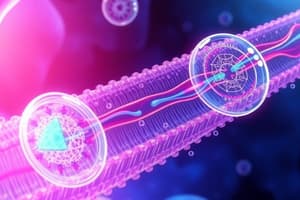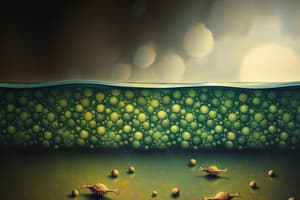Podcast
Questions and Answers
What is the primary distinction between passive and active transport across biological membranes?
What is the primary distinction between passive and active transport across biological membranes?
- Active transport moves molecules against their electrochemical gradient, requiring energy, whereas passive transport follows the gradient.
- Active transport always involves the movement of water, whereas passive transport does not.
- Passive transport relies on protein channels, while active transport only uses the lipid bilayer. (correct)
- Passive transport requires cellular energy, while active transport does not.
Which of the following factors primarily determines the rate of simple passive diffusion through an artificial lipid bilayer?
Which of the following factors primarily determines the rate of simple passive diffusion through an artificial lipid bilayer?
- The saturation level of the bilayer with proteins.
- The electrochemical potential difference and permeability constant. (correct)
- The rate of ATP hydrolysis near the membrane.
- The presence of cholesterol in the bilayer.
In the context of passive diffusion in the human body, which process exemplifies gas exchange?
In the context of passive diffusion in the human body, which process exemplifies gas exchange?
- Hormone transport in the bloodstream.
- Nutrient absorption in the small intestine.
- Oxygen and carbon dioxide exchange in the alveoli of the lungs. (correct)
- Reabsorption of water in the collecting duct of the kidney.
What role does the lipid-water partition coefficient (R) play in the transport of hydrophobic molecules across cell membranes?
What role does the lipid-water partition coefficient (R) play in the transport of hydrophobic molecules across cell membranes?
How do general anesthetics that embed in the cell membrane alter ion channel gating?
How do general anesthetics that embed in the cell membrane alter ion channel gating?
Why might lidocaine, a local anesthetic, be more effective in inflamed tissues compared to bupivacaine?
Why might lidocaine, a local anesthetic, be more effective in inflamed tissues compared to bupivacaine?
How does the Henderson-Hasselbalch equation relate to the intracellular distribution of amphiphilic materials?
How does the Henderson-Hasselbalch equation relate to the intracellular distribution of amphiphilic materials?
Why do 'lysosomotropic amines' accumulate in lysosomes?
Why do 'lysosomotropic amines' accumulate in lysosomes?
What is a key characteristic of facilitated diffusion that distinguishes it from simple diffusion?
What is a key characteristic of facilitated diffusion that distinguishes it from simple diffusion?
How does simple diffusion differ from facilitated diffusion with regard to transport rate?
How does simple diffusion differ from facilitated diffusion with regard to transport rate?
What is the role of GLUT proteins in glucose transport?
What is the role of GLUT proteins in glucose transport?
How do carrier-type ionophore antibiotics function in facilitated diffusion?
How do carrier-type ionophore antibiotics function in facilitated diffusion?
What is a key characteristic of ion channels that distinguishes them from simple pores?
What is a key characteristic of ion channels that distinguishes them from simple pores?
What is the main function of gap junctions?
What is the main function of gap junctions?
What is the relationship between intracellular calcium concentration ([Ca²⁺]i) and gap junction channel (GJC) function?
What is the relationship between intracellular calcium concentration ([Ca²⁺]i) and gap junction channel (GJC) function?
How does the solubility of a transported substance influence its movement across the membrane?
How does the solubility of a transported substance influence its movement across the membrane?
How do transdermal drug delivery systems (TDDS) leverage passive transport?
How do transdermal drug delivery systems (TDDS) leverage passive transport?
What is the role of ATP in passive transport?
What is the role of ATP in passive transport?
How does the charge of a particle impact its movement across a membrane?
How does the charge of a particle impact its movement across a membrane?
How does the thickness of the membrane impact transport?
How does the thickness of the membrane impact transport?
How does hyperpolarization affect suppression of neuronal excitability?
How does hyperpolarization affect suppression of neuronal excitability?
What happens to lysosomotropic amines in physiological environments?
What happens to lysosomotropic amines in physiological environments?
What is the function of connexin?
What is the function of connexin?
How does facilitated diffusion compare to active diffusion?
How does facilitated diffusion compare to active diffusion?
Which of the following molecules is permeable to gap junctions?
Which of the following molecules is permeable to gap junctions?
Which of the following can cause the closing of GJC?
Which of the following can cause the closing of GJC?
Which of the following is an example of passive transport?
Which of the following is an example of passive transport?
Which of the following factors does not determine transport?
Which of the following factors does not determine transport?
What is diffusion?
What is diffusion?
Flashcards
Passive Transport
Passive Transport
Movement across cell membranes without energy input.
Carrier Protein
Carrier Protein
A membrane protein that facilitates the movement of specific molecules or ions across a membrane.
Ligand-gated Ion Channel
Ligand-gated Ion Channel
A protein channel in a cell membrane that opens or closes in response to a particular neurotransmitter.
Mechanically-gated Ion Channel
Mechanically-gated Ion Channel
Signup and view all the flashcards
Always Open Ion Channel
Always Open Ion Channel
Signup and view all the flashcards
Voltage-gated Ion Channel
Voltage-gated Ion Channel
Signup and view all the flashcards
Gap Junctions
Gap Junctions
Signup and view all the flashcards
Connexon
Connexon
Signup and view all the flashcards
Lipid Bilayer
Lipid Bilayer
Signup and view all the flashcards
Uniport
Uniport
Signup and view all the flashcards
Co-transport
Co-transport
Signup and view all the flashcards
Symport
Symport
Signup and view all the flashcards
Antiport
Antiport
Signup and view all the flashcards
Simple Diffusion
Simple Diffusion
Signup and view all the flashcards
Rate of Diffusion Factors
Rate of Diffusion Factors
Signup and view all the flashcards
Lipid-water Partition Coefficient
Lipid-water Partition Coefficient
Signup and view all the flashcards
Passive Diffusion Examples
Passive Diffusion Examples
Signup and view all the flashcards
pKa Definition
pKa Definition
Signup and view all the flashcards
Lysosomal Trapping
Lysosomal Trapping
Signup and view all the flashcards
Facilitated diffusion requirements
Facilitated diffusion requirements
Signup and view all the flashcards
Ion Channel Selectivity
Ion Channel Selectivity
Signup and view all the flashcards
Ion Channel Gating
Ion Channel Gating
Signup and view all the flashcards
Permeability Constant (P)
Permeability Constant (P)
Signup and view all the flashcards
GABAA receptor
GABAA receptor
Signup and view all the flashcards
TDDS
TDDS
Signup and view all the flashcards
Liposomes
Liposomes
Signup and view all the flashcards
Study Notes
Passive Transport Overview
- Lecture slides marked with an exclamation contain critical information for tests/exams.
- Passive transport is explored through biological membranes
- Other topics include pH-dependent partitioning, facilitated diffusion, ion channels, and gap junctions.
- Passive transport also covers diffusion, hydrophobic molecule transport, and lipid-water partition coefficient; anesthetics, TDDS (Transdermal Drug Delivery Systems), and liposomes also play key roles.
Membrane Transport Classification
- Membrane structure includes lipid bilayers or complete biological membranes in one or two layers
- Energetics distinguishes passive transport (simple/facilitated diffusion) from active transport (primary/secondary)
- Transport categorisation depends on the number and direction of transported substances (uniport, symport, antiport) and solubility (hydrophilic/hydrophobic)
- R = C(l) / C(w) stands for the partitioning coefficient where l and w refer to lipid and water
Passive vs. Active Transport
- Passive occurs along electrochemical gradient
- Active happens against electrochemical gradient
Simple Diffusion Factors
- Rate is determined by concentration gradient, charge/membrane potential, total electrochemical potential difference, and permeability
- Rate is calculated as P = R * D(l) / d, where P is permeability, R is the lipid-water partition coefficient, D(l) is diffusion constant, and d is membrane thickness
Fick's Law
- Fick's Law, which models diffusion processes, typically includes equations that address the movement of charged particles, emphasizing their behavior across concentration gradients.
- Modified for cell membranes considering permeability, area, concentration difference, charge, and water-lipid partitioning
- Variables include permeability, water-lipid partition coefficient, diffusion constant, and membrane thickness.
Diffusion in the Body
- Gas exchange in alveoli is an example in the Lungs
- Reabsorption in renal tubules is an example in the Kidneys
Hydrophobic Molecules
- Passive depends on the molecule's lipid/water partition coefficient (R)
- Hydrophobicity means R > 1
- Henderson-Hasselbalch equation calculates the concentrations of protonated and unprotonated forms relative to pH and pKa.
Lipid-Water Partition Coefficient (R)
- For small, non-charged molecules, R determines the accumulation in cell membranes
- Higher R results in higher concentration in the membrane/cytosol
- General anesthetics effectiveness is proportional to R; lipid solubility matters
General Anesthetics
- Embedding general anaesthetics in the membrane increases lateral pressure and activates phospholipase D to generate phosphatidic acid
- This process can activate K+ channels and cause hyperpolarization
- Ether in the cell membrane activates K+ channels
- Hydrostatic pressure reverses this effect by expelling ether molecules
Anesthetics and Receptors
- Group 1, intravenous (etomidate, propofol, barbiturates), acts on GABA(A) receptors (chloride channels)
- Group 2, inhaled (ketamine, N₂O, Xenon, cyclopropane), inhibits NMDA receptors and activates leak K+ channels
- Group 3, inhaled (halothane, flurane, isoflurane, sevoflurane, desflurane), activates GABA(A) and leak K+ channels while inhibiting NMDAR, nAChR, mKATP, SR3, Nav Channels and HCN channels
TDDS
- Transdermal drug delivery systems are topical/transdermal for hydrophobic drug transfer
- Stratum corneum barrier is surpassed when drugs have high lipid-water partition coefficient (increased with prevented evaporation)
- Factors include skin permeability, surface area, blood/lymphatic supply etc
- Transdermal patches can be easily removed and provide comfortable, controlled delivery
Liposomes
- These work by fusing with cell membranes to deliver a non-specific uptake for cancer-therapy and vaccination
pH-Dependent Partitioning
- The Henderson-Hasselbalch equation is a fundamental relationship in biochemistry and pharmacology that describes the relationship between the pH of a solution, the pKa of a weak acid or base, and the ratio of the ionized and unionized forms of amphiphilic substances. This equation is crucial for predicting how these materials will distribute themselves in different environments within the body.
- Lysosomotropic amines are a class of compounds that preferentially localize in lysosomes, which are membrane-bound organelles that maintain an acidic environment. The ionization of these amines is influenced by the low pH, leading to their accumulation due to the pH-dependent partitioning where the charged form is trapped within the lysosome.
- Such drug sequestration can have deleterious effects on cellular function, as it can alter the pharmacokinetics of the drug. Local anesthetics, particularly lidocaine, serve as pertinent examples, wherein their accumulation in lysosomes can impact their efficacy and safety profile.
Local Anesthetics
- They include bupivacaine, lidocaine, mepivacaine, procaine, ropivacaine, and tetracaine.
- Local anesthetics block sodium channels from the intracellular side and suppress neuronal excitability
- Lidocaine has higher levels of cell penetration when the extracellular space is acidic
Daunorubicin
- Daunorubicin accumulation in lysosomes accumulates because it is an amine that accumulates in acidic lysosomes as a DNA-intercalating cancer drug.
- Effectiveness is reduced by sequestering action in the lysosomes
Facilitated Diffusion
- Process moves molecules along the electrochemical gradient without energy
- Transporter molecules bind specifically to transported molecules
- GLUT1-5 transporters, for example, bind D-glucose but not the L isomeric variant
Facilitated Diffusion cont.
- Transport rate is limited by the number and rate of transfer of transport molecules
- Specific antagonists can inhibit it (unlike simple diffusion)
Glucose Transporters (GLUTs)
- Glucose uniport into cells is facilitated by GLUT proteins.
- Expression varies by tissue; GLUT3 in the brain, GLUT2 in liver and intestine, GLUT4 in muscle and fatty tissue
Ion Channels
- Selective pores facilitate ion diffusion down electrochemical gradients
- Facilitated diffusion rate is very effective for intracellular ion concentration regulation
- Controlled, or gated, opening acts as a signaling switch for AP generation and calcium-level elevation
Types of Ion Channels
- Include voltage-gated and ligand-gated
- Other types comprise IC signal-gated and G-protein-gated
- Stretch/mechanically-gated Leak/background channels (always open) also exist
Gap Junction Diffusion
- Small molecules below 2 kDa, both polar and non-polar can travel through the cell
- EM* images demonstrate what the process looks like on a microscopic level
- Examples of substances include ATP, ADP, cAMP, IP3, Ca2+, etc
Intercellular Trafficking
- Gap junction channels (GJC) mediate intercellular communication via connexins or connexons
- Connexons make hemichannels to transport signals
Gap Junctions
- GJC closure is induced by dopamine via increased intracellular calcium, as well as high H+ concentration (low pH) via the ball-and-chain model
- Voltage-gating in cardiac cells and phosphorylation modulate GJC conductivity and assembly
Keywords
- Relevant terms include being apolar/nonpolar, polar, amphipatic molecule, and more
- Facilitated diffusion, passive transport, and how lipid-water partitioning coefficients contribute
- Glucose uniport, ion channel gating/selectivity, gap junctions, plus connexins, GJC, and voltage sensors further inform the topic
Studying That Suits You
Use AI to generate personalized quizzes and flashcards to suit your learning preferences.




